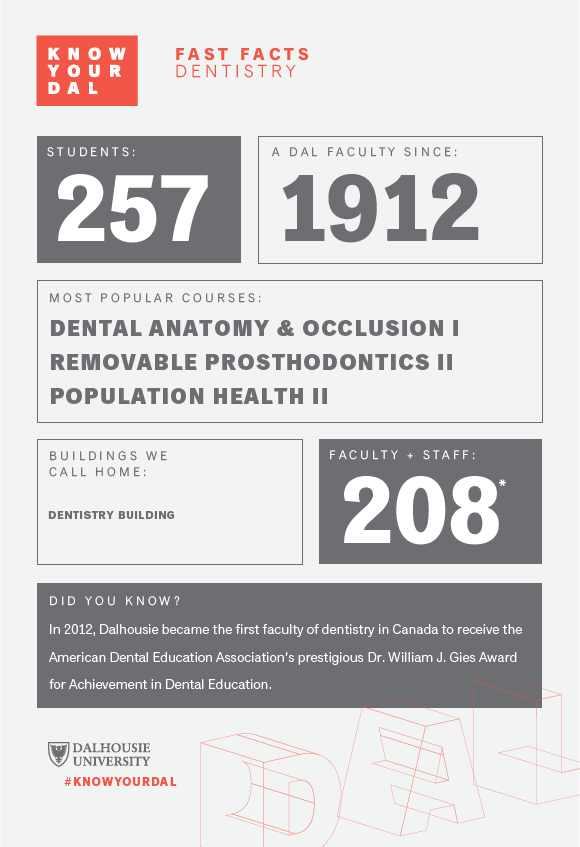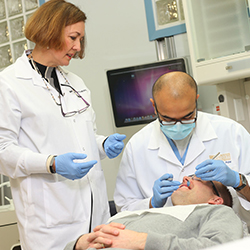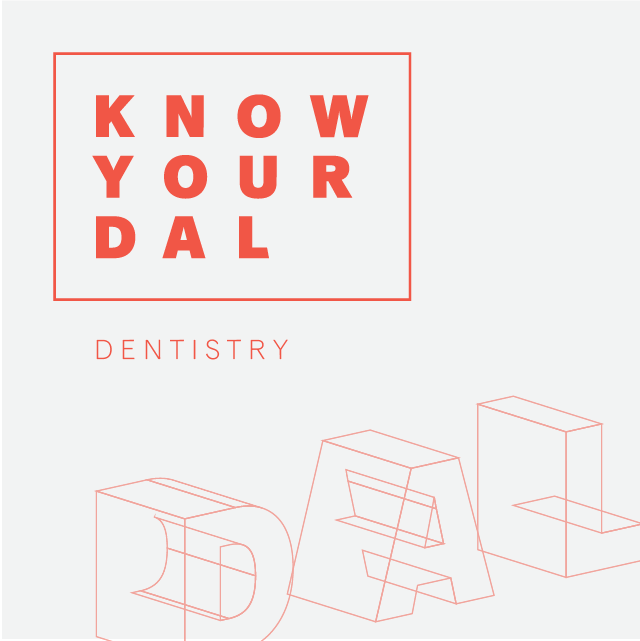When the four graduates of HÂţ»â€™s Class of 1912 received their Doctor in Dental Surgery degrees, the education of dentists in Canada changed forever.
That’s because Dal’s Faculty of Dentistry was the first dentistry faculty in Canada. Today, 103 years later, it remains the only dental school in Atlantic Canada, offering diploma, undergraduate and graduate programs in Dentistry and Dental hygiene and teaching students from around the world.
Here are five things you might be surprised to learn about the HÂţ» Faculty of Dentistry.

*135 full-time and part-time faculty and 73 support staff.
1. We operate a full dental hospital on the HÂţ» campus
Walk into the dentistry building on the corner of Robie Street and University Avenue on any given weekday morning between 8:30 and 9 a.m. and you’ll be greeted by a lineup of patients waiting to check in at reception for their appointments at the clinic.
 Some 200-250 patients are seen every day for a total of over 26,000 in the course of a year. Dental Hygiene students begin treating patients midway through the first year of their program and dental students in their second year. By the time they get to their fourth year, our students will have 60 to 80 patients in their “patient family.” A full range of services is offered in the clinic, from fillings, cleanings, and emergency treatment to extractions, root canals, crowns and implants.
Some 200-250 patients are seen every day for a total of over 26,000 in the course of a year. Dental Hygiene students begin treating patients midway through the first year of their program and dental students in their second year. By the time they get to their fourth year, our students will have 60 to 80 patients in their “patient family.” A full range of services is offered in the clinic, from fillings, cleanings, and emergency treatment to extractions, root canals, crowns and implants.
A major clinic renewal project is currently underway that will transform the clinic into a teaching environment, which will better prepare students for working in a practice setting and enhance the service it offers the Halifax community. Scheduled for completion in 2019, the clinic will have new and improved space for teaching and learning, and its ability to provide high-calibre research, education and patient care will be enhanced.
2. Our pre-loaded laptop computers are a key component of our students’ toolkits
The Dal Faculty of Dentistry was the first dental faculty in Canada to bring in a laptop program for students. Introduced to first-year Dentistry students in 2006 and first-year dental hygiene students in 2009, the program provides students with a MacBook Pro pre-loaded with 100+ textbooks — all the required texts for their entire curriculum. Students benefit from always having the most up-to-date versions of material, and can search, highlight, and share material in mere seconds. Through their laptops, students also have full access to electronic patient charts and X-rays and can schedule patient appointments. “The laptop is light and portable and contains everything you need,” says third-year Dentistry student Amanda Suh. “It’s a great system.”
3. Our community outreach clinics help underserved communities
Dentistry and Dental Hygiene students have many opportunities to take their classroom and clinic learning out into the community. In the Halifax area, Dental Hygiene students undertake rotations at Harbour View School in Dartmouth, while Dentistry students gain similar experience at Nelson Whynder Elementary School in North Preston. Underserved communities benefit from dental care for children right in the schools, while students gain invaluable experience in paediatric care.
Other rotations take students to the North End Community Health Clinic, to small communities in northern Labrador, and to the Veterans Centre of the QEII Hospital. Dental Hygiene students also work with the Immigrant Services Association of Nova Scotia to meet the dental needs of refugees. There is no question that these communities and groups benefit from the oral health care information and treatment the students and faculty provide. Just as importantly, students have their eyes opened to the needs of others and learn the value of community outreach.
4. Our researchers do ground-breaking research Ěý
Our faculty members currently lead or co-lead around $5.4 million in active research grants. Areas of research include clinical research, microbiology, biomaterials and population health. Our researchers assess the oral health of vulnerable populations, work to improve the oral care of seniors in long-term care facilities, test new ways to detect early caries, find new methods to target bacteria that cause tooth decay and periodontal disease, and develop novel materials for dental restorations and bone repair. They often work collaboratively with other Dal Faculties and programs, such as nursing, medicine, health professions, engineering, and computer science, as well as local hospitals.
5. Our dean has a collection of 50+ Tiggers from around the world
 It started it as a joke on a family holiday, when Dean Tom Boran’s sons told him that he was a lot like Tigger, the iconic character from the Winnie the Pooh stories: energetic, friendly, and positive. And then it spread. One Tigger stuffed toy on the bookshelf led to many more, mostly as gifts from students over the years, until it grew into sizable collection that now includes figurines, mugs, and snow globes from around the world. There is even a treasured Tigger rug, hooked by Dr. Boran’s elderly father. “Everyone knows Tigger and what he represents,” says Dr. Boran, “which is a positive outlook and a sense of fun. And I hope I have brought some of that to the teaching of dentistry.” Thinking ahead to retirement, Dr. Boran plans to start giving out his Tiggers as a way of passing those positive feelings onto friends and colleagues.
It started it as a joke on a family holiday, when Dean Tom Boran’s sons told him that he was a lot like Tigger, the iconic character from the Winnie the Pooh stories: energetic, friendly, and positive. And then it spread. One Tigger stuffed toy on the bookshelf led to many more, mostly as gifts from students over the years, until it grew into sizable collection that now includes figurines, mugs, and snow globes from around the world. There is even a treasured Tigger rug, hooked by Dr. Boran’s elderly father. “Everyone knows Tigger and what he represents,” says Dr. Boran, “which is a positive outlook and a sense of fun. And I hope I have brought some of that to the teaching of dentistry.” Thinking ahead to retirement, Dr. Boran plans to start giving out his Tiggers as a way of passing those positive feelings onto friends and colleagues.
Learn more about the Faculty of Dentistry .
 This article is part of "Know Your Dal," a 13-week series highlighting Dal's academic community. For more, including additional content from the Faculty of Dentistry, visit .
This article is part of "Know Your Dal," a 13-week series highlighting Dal's academic community. For more, including additional content from the Faculty of Dentistry, visit .
Ěý

